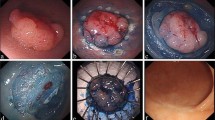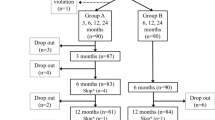Abstract
Purpose
To investigate advanced neoplasia (AN) after endoscopic mucosal resection (EMR) of colonic laterally spreading lesions (LSLs).
Methods
A retrospective study of patients who underwent injection-assisted EMR of colonic LSLs ≥ 10 mm was performed. Primary outcome was overall rate of AN at initial surveillance colonoscopy. Secondary outcomes were the rates of residual AN (rAN) at the EMR site and metachronous AN (mAN), and analysis of risk factors for AN, including effect of surveillance guidance.
Results
Three hundred seventy-four patients underwent successful EMR for 388 LSLs. AN occurred in 66/374 (17.6%) patients on initial surveillance colonoscopy at median follow-up of 364.5 days. Two patients had both rAN and mAN, for a total of 68 instances of AN, including 30/374 (8.0%) cases of rAN and 38/374 (10.2%) cases of mAN. On multivariate analysis, use of piecemeal resection was associated with increased likelihood of residual AN (P = 0.003, OR 9.2, 95% CI 2.1–33.3). Twenty-nine out of thirty cases (96.7%) of rAN were successfully endoscopically managed at surveillance colonoscopy.
Conclusions
AN occurred in 17.6% of all patients at initial surveillance colonoscopy at a median of 1 year after EMR. Roughly half of the instances of AN were metachronous lesions. Our data support a 1-year surveillance interval after EMR of LSLs ≥ 10 mm with careful inspection of the entire colon, not just the prior resection site.

Similar content being viewed by others
References
Lieberman DA, Rex DK, Winawer SJ, Giardiello FM, Johnson DA, Levin TR (2012) Guidelines for colonoscopy surveillance after screening and polypectomy: a consensus update by the US Multi-Society Task Force on Colorectal Cancer. Gastroenterology 143:844–857
Regula J, Rupinski M, Kraszewska E, Polkowski M, Pachlewski J, Orlowska J, Nowacki MP, Butruk E (2006) Colonoscopy in colorectal-cancer screening for detection of advanced neoplasia. N Engl J Med 355:1863–1872
Kaku E, Oda Y, Murakami Y, Goto H, Tanaka T, Hasuda K, Yasunaga M, Ito K, Sakurai K, Fujimori T, Hattori M, Sasaki Y (2011) Proportion of flat- and depressed-type and laterally spreading tumor among advanced colorectal neoplasia. Clin Gastroenterol Hepatol 9:503–508
Chung SJ, Kim YS, Yang SY, Song JH, Kim D, Park MJ, Kim SG, Song IS, Kim JS (2011) Five-year risk for advanced colorectal neoplasia after initial colonoscopy according to the baseline risk stratification: a prospective study in 2452 asymptomatic Koreans. Gut 60:1537–1543
Cubiella J, Carballo F, Portillo I, Cruzado Quevedo J, Salas D, Binefa G, Milà N, Hernández C, Andreu M, Terán Á, Arana-Arri E, Ono A, Valverde MJ, Bujanda L, Hernández V, Morillas JD, Jover R, Castells A (2016) Incidence of advanced neoplasia during surveillance in high- and intermediate-risk groups of the European colorectal cancer screening guidelines. Endoscopy 48:995–1002
Martinez ME, Baron JA, Lieberman DA et al (2009) A pooled analysis of advanced colorectal neoplasia diagnoses after colonoscopic polypectomy. Gastroenterology 136:832–841
Nguyen SP, Bent S, Chen YH, Terdiman JP (2009) Gender as a risk factor for advanced neoplasia and colorectal cancer: a systematic review and meta-analysis. Clin Gastroenterol Hepatol 7:676–681 e1-3
Saini SD, Kim HM, Schoenfeld P (2006) Incidence of advanced adenomas at surveillance colonoscopy in patients with a personal history of colon adenomas: a meta-analysis and systematic review. Gastrointest Endosc 64:614–626
Buchner AM, Guarner-Argente C, Ginsberg GG (2012) Outcomes of EMR of defiant colorectal lesions directed to an endoscopy referral center. Gastrointest Endosc 76:255–263
Swan MP, Bourke MJ, Alexander S, Moss A, Williams SJ (2009) Large refractory colonic polyps: is it time to change our practice? A prospective study of the clinical and economic impact of a tertiary referral colonic mucosal resection and polypectomy service (with videos). Gastrointest Endosc 70:1128–1136
Rao AK, Soetikno R, Raju GS, Lum P, Rouse RV, Sato T, Titzer-Schwarzl D, Aisenberg J, Kaltenbach T (2016) Large sessile serrated polyps can be safely and effectively removed by endoscopic mucosal resection. Clin Gastroenterol Hepatol 14:568–574
Jayanna M, Burgess NG, Singh R, Hourigan LF, Brown GJ, Zanati SA, Moss A, Lim J, Sonson R, Williams SJ, Bourke MJ (2016) Cost analysis of endoscopic mucosal resection vs surgery for large laterally spreading colorectal lesions. Clin Gastroenterol Hepatol 14:271–278
Gomez V, Racho RG, Woodward TA et al (2014) Colonic endoscopic mucosal resection of large polyps: is it safe in the very elderly? Dig Liver Dis 46:701–705
Hassan C, Quintero E, Dumonceau JM, Regula J, Brandão C, Chaussade S, Dekker E, Dinis-Ribeiro M, Ferlitsch M, Gimeno-García A, Hazewinkel Y, Jover R, Kalager M, Loberg M, Pox C, Rembacken B, Lieberman D, European Society of Gastrointestinal Endoscopy (2013) Post-polypectomy colonoscopy surveillance: European Society of Gastrointestinal Endoscopy (ESGE) guideline. Endoscopy 45:842–851
Elta GH (2012) What is a defiant polyp and how good are we at removing them? Gastrointest Endosc 76:264–266
Lambert R, Kudo SE, Vieth M et al (2009) Pragmatic classification of superficial neoplastic colorectal lesions. Gastrointest Endosc 70:1182–1199
Chandrasekhara V, Ginsberg GG (2011) Endoscopic mucosal resection: not your father’s polypectomy anymore. Gastroenterology 141:42–49
Bourke MJ (2011) Endoscopic mucosal resection in the colon: a practical guide. Tech Gastrointest Endosc 13:35–49
Committee AT, Hwang JH, Konda V et al (2015) Endoscopic mucosal resection. Gastrointest Endosc 82:215–226
Desomer L, Tutticci N, Tate DJ, Williams SJ, McLeod D, Bourke MJ (2017) A standardized imaging protocol is accurate in detecting recurrence after EMR. Gastrointest Endosc 85:518–526
Schreiner MA, Weiss DG, Lieberman DA (2010) Proximal and large hyperplastic and nondysplastic serrated polyps detected by colonoscopy are associated with neoplasia. Gastroenterology 139:1497–1502
Corley DA, Jensen CD, Marks AR, Zhao WK, Lee JK, Doubeni CA, Zauber AG, de Boer J, Fireman BH, Schottinger JE, Quinn VP, Ghai NR, Levin TR, Quesenberry CP (2014) Adenoma detection rate and risk of colorectal cancer and death. N Engl J Med 370:1298–1306
Samadder NJ, Curtin K, Tuohy TM et al (2014) Characteristics of missed or interval colorectal cancer and patient survival: a population-based study. Gastroenterology 146:950–960
le Clercq CM, Bouwens MW, Rondagh EJ et al (2014) Postcolonoscopy colorectal cancers are preventable: a population-based study. Gut 63:957–963
Cooper GS, Xu F, Barnholtz Sloan JS, Schluchter MD, Koroukian SM (2012) Prevalence and predictors of interval colorectal cancers in medicare beneficiaries. Cancer 118:3044–3052
McGill SK, Soetikno R, Rouse RV et al (2017) Patients with nonpolypoid (flat and depressed) colorectal neoplasms at increased risk for advanced neoplasias, compared with patients with polypoid neoplasms. Clin Gastroenterol Hepatol 15:249–256
Winawer SJ, Zauber AG, O’Brien MJ, Ho MN, Gottlieb L, Sternberg SS, Waye JD, Bond J, Schapiro M, Stewart ET, Panish J, Ackroyd F, Kurtz RC, Shike M (1993) Randomized comparison of surveillance intervals after colonoscopic removal of newly diagnosed adenomatous polyps. The National Polyp Study Workgroup. N Engl J Med 328:901–906
Moss A, Williams SJ, Hourigan LF, Brown G, Tam W, Singh R, Zanati S, Burgess NG, Sonson R, Byth K, Bourke MJ (2015) Long-term adenoma recurrence following wide-field endoscopic mucosal resection (WF-EMR) for advanced colonic mucosal neoplasia is infrequent: results and risk factors in 1000 cases from the Australian Colonic EMR (ACE) study. Gut 64:57–65
Khashab M, Eid E, Rusche M, Rex DK (2009) Incidence and predictors of “late” recurrences after endoscopic piecemeal resection of large sessile adenomas. Gastrointest Endosc 70:344–349
Bick BL, Ponugoti PL, Rex DK (2017) High yield of synchronous lesions in referred patients with large lateral spreading colorectal tumors. Gastrointest Endosc 85:228–233
Lim SH, Levenick JM, Mathew A, Moyer MT, Dye CE, McGarrity TJ (2016) Endoscopic management of large (>/=2 cm) non-pedunculated colorectal polyps: impact of polyp morphology on outcomes. Dig Dis Sci 61:3572–3583
Woodward TA, Heckman MG, Cleveland P, de Melo S, Raimondo M, Wallace M (2012) Predictors of complete endoscopic mucosal resection of flat and depressed gastrointestinal neoplasia of the colon. Am J Gastroenterol 107:650–654
Saito Y, Fukuzawa M, Matsuda T, Fukunaga S, Sakamoto T, Uraoka T, Nakajima T, Ikehara H, Fu KI, Itoi T, Fujii T (2010) Clinical outcome of endoscopic submucosal dissection versus endoscopic mucosal resection of large colorectal tumors as determined by curative resection. Surg Endosc 24:343–352
Seidel J, Färber E, Baumbach R et al (2012) Complication and local recurrence rate after endoscopic resection of large high-risk colorectal adenomas of ≥ 3 cm in size. Int J Color Dis 31:603–611
Author information
Authors and Affiliations
Corresponding author
Ethics declarations
This retrospective observational study was approved by the Institutional Review Board at the University of Pennsylvania.
Conflict of interest
The author N.A. reports that spouse is employed with AstraZeneca and receives stock from Bristol-Myers Squibb. The author M.K. reports that his spouse is employed at Merck and he serves as a consultant with Boston Scientific and Dark Canyon Laboratory. The author G.G. serves as a consultant for Olympus Inc., Boston Scientific, Micro Interventional Devices, and Fractyl. The author V.C. serves as a consultant for Boston Scientific. All authors report no other conflicts of interest.
Rights and permissions
About this article
Cite this article
Agarwal, A., Garimall, S., Colling, C. et al. Incidence and risk factors of advanced neoplasia after endoscopic mucosal resection of colonic laterally spreading lesions. Int J Colorectal Dis 33, 1333–1340 (2018). https://doi.org/10.1007/s00384-018-3075-x
Accepted:
Published:
Issue Date:
DOI: https://doi.org/10.1007/s00384-018-3075-x




